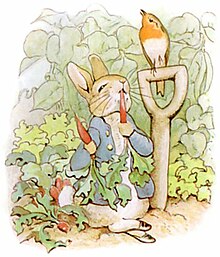
Back Peter Rabbit AST Pere Conillet Catalan Peter Kanin Danish Peter Rabbit Spanish Peter Rabbit Galician Փիթեր նապաստակ Armenian Peter Rabbit ID ピーターラビット Japanese 피터 래빗 Korean Peter Rabbit Malay
| Peter Rabbit | |
|---|---|
 | |
| First appearance | The Tale of Peter Rabbit (1902) |
| Created by | Beatrix Potter |
| Voiced by | Rory Carty (1992–1994) Mark Lockyer (1995) Cam Clarke (1995) Connor Fitzgerald (2012–2014) Harry Henty (2014–2016) James Corden (2018–present) Sienna Adams (2019) |
| In-universe information | |
| Species | European rabbit |
| Gender | Male |
| Family | Mr. Rabbit (father, deceased) Mrs. Rabbit (mother) Benjamin Bunny (cousin/brother in-law) Flopsy Rabbit/Flopsy Bunny (sister/cousin-in-law) Mopsy and Cotton-tail (sisters) |
| Relatives | Bouncer (uncle) Benjamin and Flopsy's children (nephews and nieces/cousins-once removed) unnamed brother-in-law by Cotton-tail |
| Nationality | English |
Peter Rabbit is a fictional animal character in various children's stories by English author Beatrix Potter.[1] A mischievous, adventurous young rabbit who wears a blue jacket, he first appeared in The Tale of Peter Rabbit in 1902, and subsequently in five more books between 1904 and 1912. The six books by Potter featuring Peter Rabbit have sold over 150 million copies.[2] Spin-off merchandise includes dishes, wallpaper, painting books, board games and dolls. In 1903, Peter Rabbit was the first fictional character to be made into a patented stuffed toy, making him the oldest licensed character.[3][4]
Peter Rabbit appears as a character in several adaptations, including the television series The World of Peter Rabbit and Friends (1992–1998) and Peter Rabbit (2012–2016), and the live-action/animated films Peter Rabbit (2018) and Peter Rabbit 2: The Runaway (2021).
- ^ MacDonald, Ruth K. (1986). Beatrix Potter. Twayne's English Author Series. Boston: Twayne Publishers. ISBN 0-8057-6917-X.
- ^ "Peter Rabbit in China copyright stew". BBC News. 23 June 2003. Archived from the original on 4 February 2009. Retrieved 31 August 2009.
- ^ Cite error: The named reference
Timeswas invoked but never defined (see the help page). - ^ "How Beatrix Potter Invented Character Merchandising". Smithsonian. Retrieved 6 October 2022.